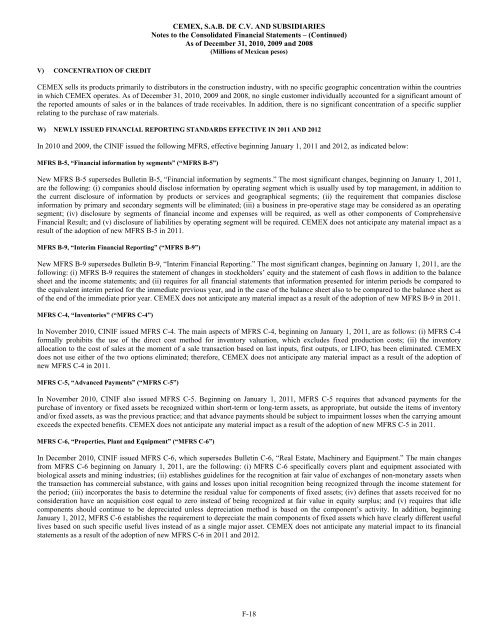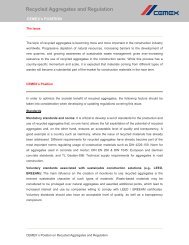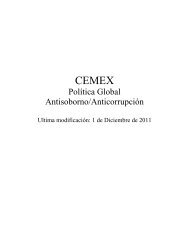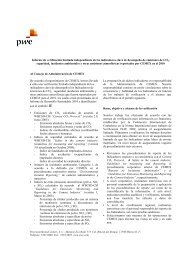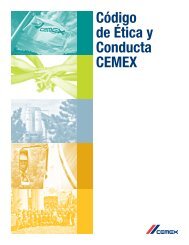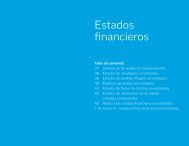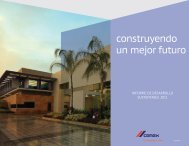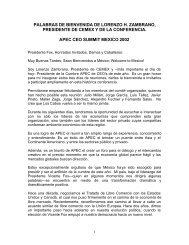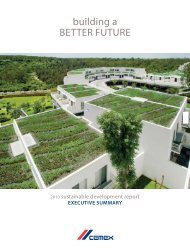building a STRONGER foundation - Cemex
building a STRONGER foundation - Cemex
building a STRONGER foundation - Cemex
Create successful ePaper yourself
Turn your PDF publications into a flip-book with our unique Google optimized e-Paper software.
V) CONCENTRATION OF CREDIT<br />
CEMEX, S.A.B. DE C.V. AND SUBSIDIARIES<br />
Notes to the Consolidated Financial Statements – (Continued)<br />
As of December 31, 2010, 2009 and 2008<br />
(Millions of Mexican pesos)<br />
CEMEX sells its products primarily to distributors in the construction industry, with no specific geographic concentration within the countries<br />
in which CEMEX operates. As of December 31, 2010, 2009 and 2008, no single customer individually accounted for a significant amount of<br />
the reported amounts of sales or in the balances of trade receivables. In addition, there is no significant concentration of a specific supplier<br />
relating to the purchase of raw materials.<br />
W) NEWLY ISSUED FINANCIAL REPORTING STANDARDS EFFECTIVE IN 2011 AND 2012<br />
In 2010 and 2009, the CINIF issued the following MFRS, effective beginning January 1, 2011 and 2012, as indicated below:<br />
MFRS B-5, “Financial information by segments” (“MFRS B-5”)<br />
New MFRS B-5 supersedes Bulletin B-5, “Financial information by segments.” The most significant changes, beginning on January 1, 2011,<br />
are the following: (i) companies should disclose information by operating segment which is usually used by top management, in addition to<br />
the current disclosure of information by products or services and geographical segments; (ii) the requirement that companies disclose<br />
information by primary and secondary segments will be eliminated; (iii) a business in pre-operative stage may be considered as an operating<br />
segment; (iv) disclosure by segments of financial income and expenses will be required, as well as other components of Comprehensive<br />
Financial Result; and (v) disclosure of liabilities by operating segment will be required. CEMEX does not anticipate any material impact as a<br />
result of the adoption of new MFRS B-5 in 2011.<br />
MFRS B-9, “Interim Financial Reporting” (“MFRS B-9”)<br />
New MFRS B-9 supersedes Bulletin B-9, “Interim Financial Reporting.” The most significant changes, beginning on January 1, 2011, are the<br />
following: (i) MFRS B-9 requires the statement of changes in stockholders’ equity and the statement of cash flows in addition to the balance<br />
sheet and the income statements; and (ii) requires for all financial statements that information presented for interim periods be compared to<br />
the equivalent interim period for the immediate previous year, and in the case of the balance sheet also to be compared to the balance sheet as<br />
of the end of the immediate prior year. CEMEX does not anticipate any material impact as a result of the adoption of new MFRS B-9 in 2011.<br />
MFRS C-4, “Inventories” (“MFRS C-4”)<br />
In November 2010, CINIF issued MFRS C-4. The main aspects of MFRS C-4, beginning on January 1, 2011, are as follows: (i) MFRS C-4<br />
formally prohibits the use of the direct cost method for inventory valuation, which excludes fixed production costs; (ii) the inventory<br />
allocation to the cost of sales at the moment of a sale transaction based on last inputs, first outputs, or LIFO, has been eliminated. CEMEX<br />
does not use either of the two options eliminated; therefore, CEMEX does not anticipate any material impact as a result of the adoption of<br />
new MFRS C-4 in 2011.<br />
MFRS C-5, “Advanced Payments” (“MFRS C-5”)<br />
In November 2010, CINIF also issued MFRS C-5. Beginning on January 1, 2011, MFRS C-5 requires that advanced payments for the<br />
purchase of inventory or fixed assets be recognized within short-term or long-term assets, as appropriate, but outside the items of inventory<br />
and/or fixed assets, as was the previous practice; and that advance payments should be subject to impairment losses when the carrying amount<br />
exceeds the expected benefits. CEMEX does not anticipate any material impact as a result of the adoption of new MFRS C-5 in 2011.<br />
MFRS C-6, “Properties, Plant and Equipment” (“MFRS C-6”)<br />
In December 2010, CINIF issued MFRS C-6, which supersedes Bulletin C-6, “Real Estate, Machinery and Equipment.” The main changes<br />
from MFRS C-6 beginning on January 1, 2011, are the following: (i) MFRS C-6 specifically covers plant and equipment associated with<br />
biological assets and mining industries; (ii) establishes guidelines for the recognition at fair value of exchanges of non-monetary assets when<br />
the transaction has commercial substance, with gains and losses upon initial recognition being recognized through the income statement for<br />
the period; (iii) incorporates the basis to determine the residual value for components of fixed assets; (iv) defines that assets received for no<br />
consideration have an acquisition cost equal to zero instead of being recognized at fair value in equity surplus; and (v) requires that idle<br />
components should continue to be depreciated unless depreciation method is based on the component’s activity. In addition, beginning<br />
January 1, 2012, MFRS C-6 establishes the requirement to depreciate the main components of fixed assets which have clearly different useful<br />
lives based on such specific useful lives instead of as a single major asset. CEMEX does not anticipate any material impact to its financial<br />
statements as a result of the adoption of new MFRS C-6 in 2011 and 2012.<br />
F-18


